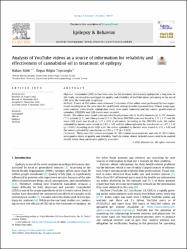Analysis of YouTube videos as a source of information for reliability and effectiveness of cannabidiol oil in treatment of epilepsy
Citation
Silek, Hakan; Topçuoğlu, Ö Bilgin. Analysis of YouTube videos as a source of information for reliability and effectiveness of cannabidiol oil in treatment of epilepsy. Epilepsy & Behavior (2023) v.138.Abstract
Objective: Cannabidiol (CBD) oil has been used for the treatment of refractory epilepsy for a long time. In this study, we aimed to investigate the quality and reliability of YouTube videos pertaining to the use of CBD oil in the treatment of epilepsy.Methods: A total of 100 videos were reviewed. Evaluation of the videos were performed by two experi-enced neurologists at the same time, but in different settings in order to prevent bias. Videos' image type, video content, video length, upload date, daily view count, comment and like counts, qualification of uploaders, DISCERN, and GQS scores were recorded.Results: The videos were found to be uploaded by physicians (46 %), health channels (33 %), TV channels (7 %), patients (2 %), and other persons (12 %). The mean DISCERN score was found as 3.71 +/- 1.17 and the mean GQS score was found as 3.21 +/- 1.05 in all videos. According to the DISCERN scale, the videos uploaded by doctors were scored as 3.82 +/- 1.02 and the videos uploaded by non-doctors as 3.07 +/- 1.12 (p < 0.001). According to the GQS scale, the videos uploaded by doctors were scored as 3.51 +/- 1.02 and the videos uploaded by non-doctors as 3.01 +/- 1.17 (p < 0.001).Conclusion: Thirty-two (32%) videos were poor, 43 (43%) videos were moderate, and only 25 (25%) videos were good in terms of quality and reliability. YouTube videos related to health issues need to be audited strictly before they can become publicly accessible.(c) 2022 Elsevier Inc. All rights reserved.
Source
Epilepsy & BehaviorVolume
138URI
https://www.sciencedirect.com/science/article/pii/S1525505022004668?via%3Dihubhttps://doi.org/10.1016/j.yebeh.2022.109017
https://hdl.handle.net/20.500.12780/641


















